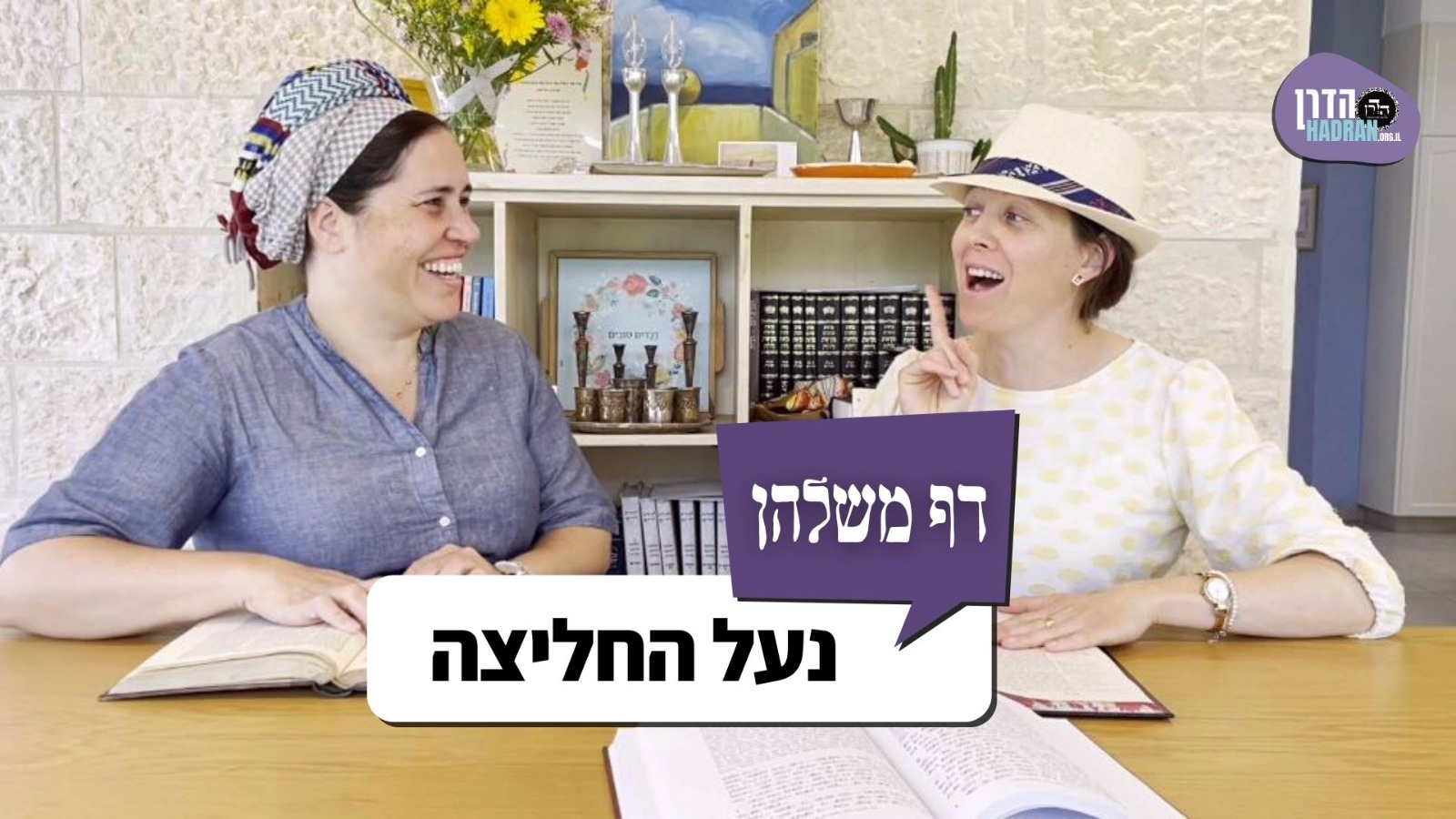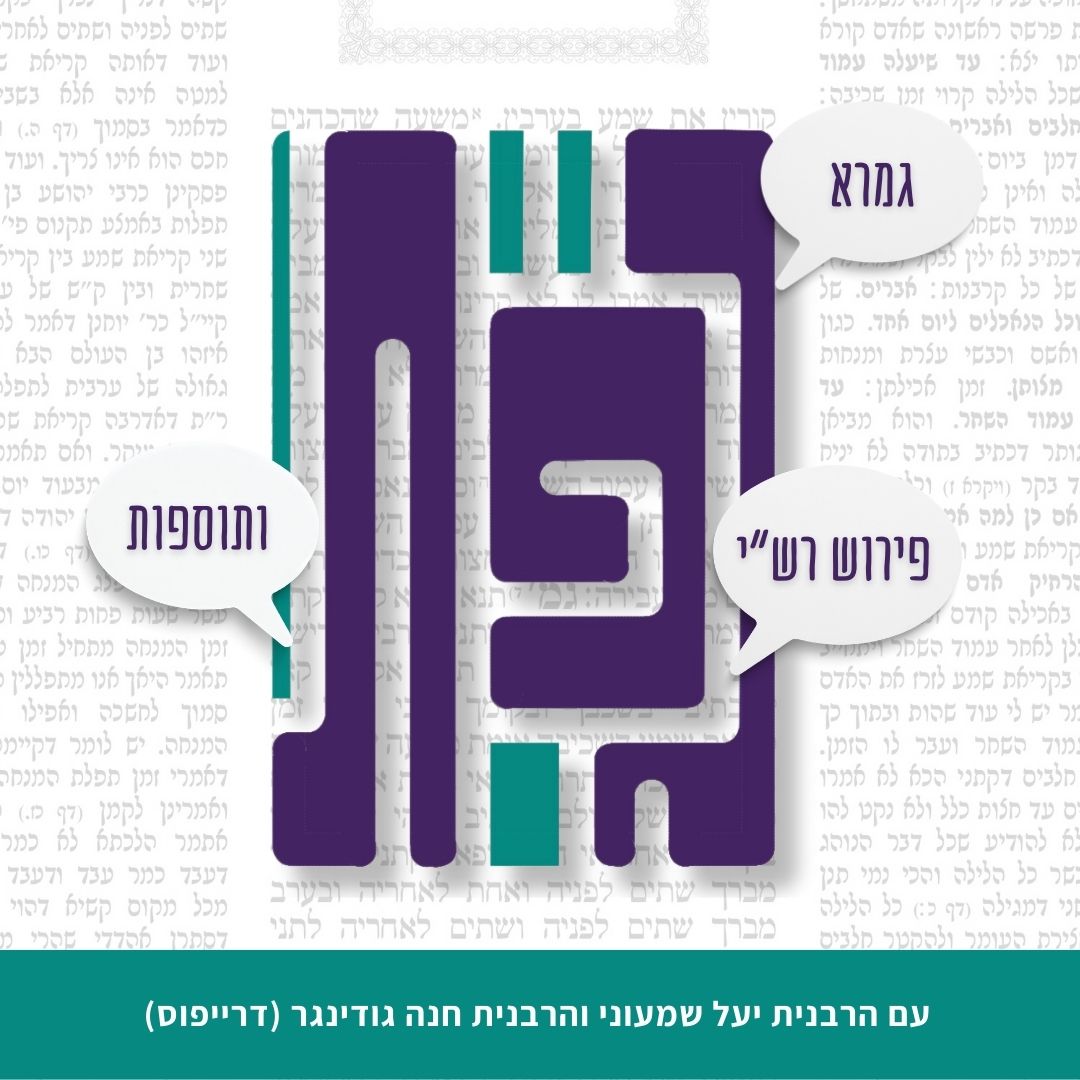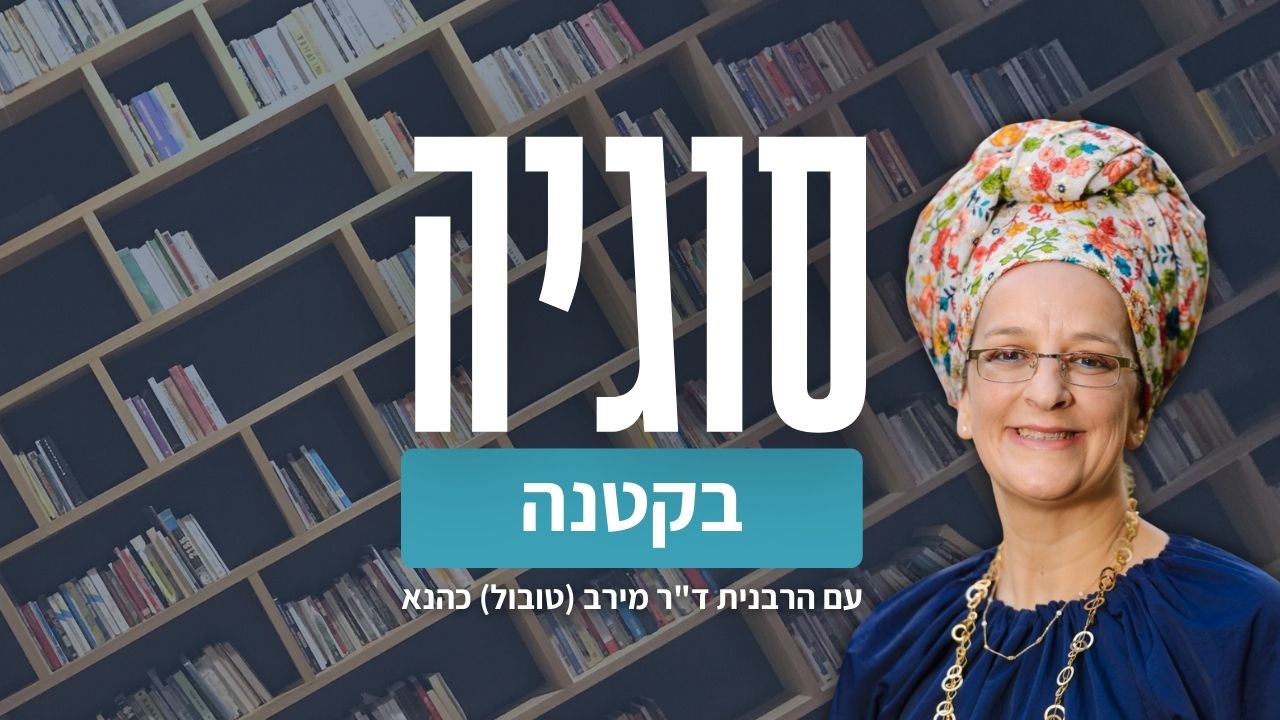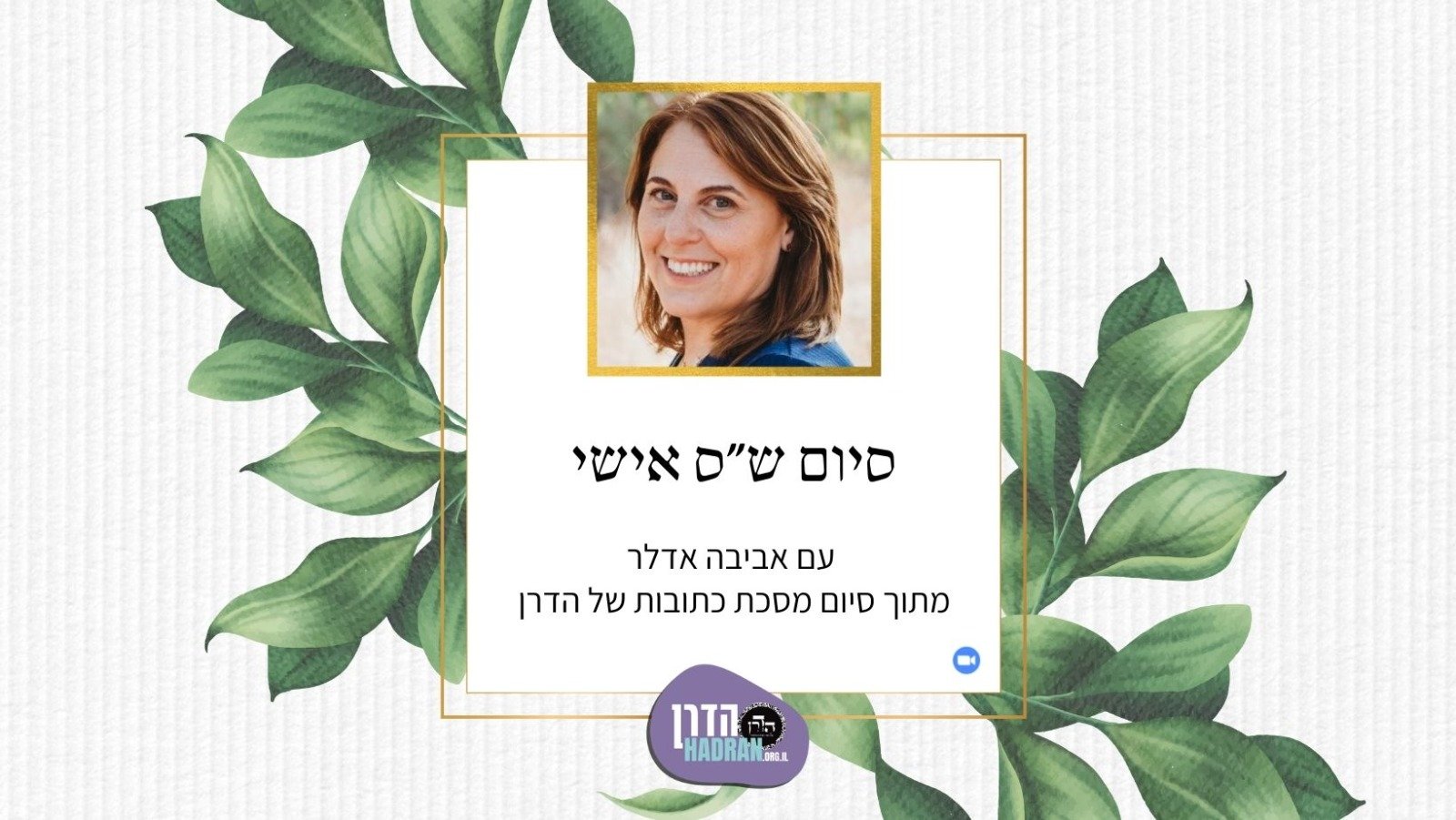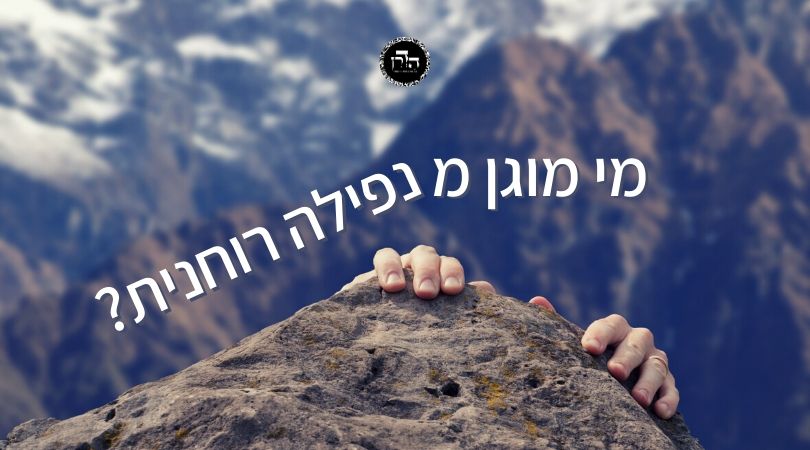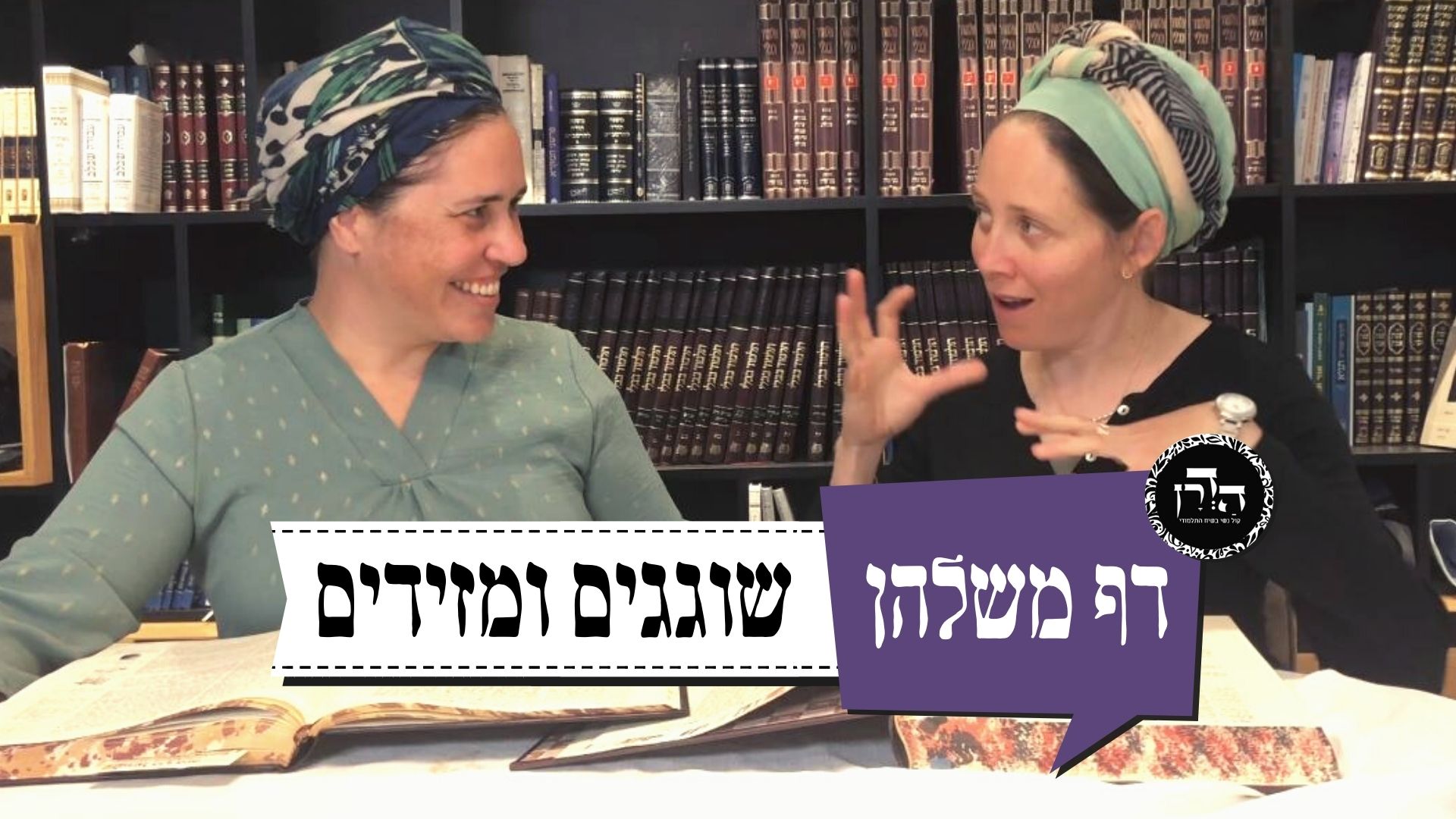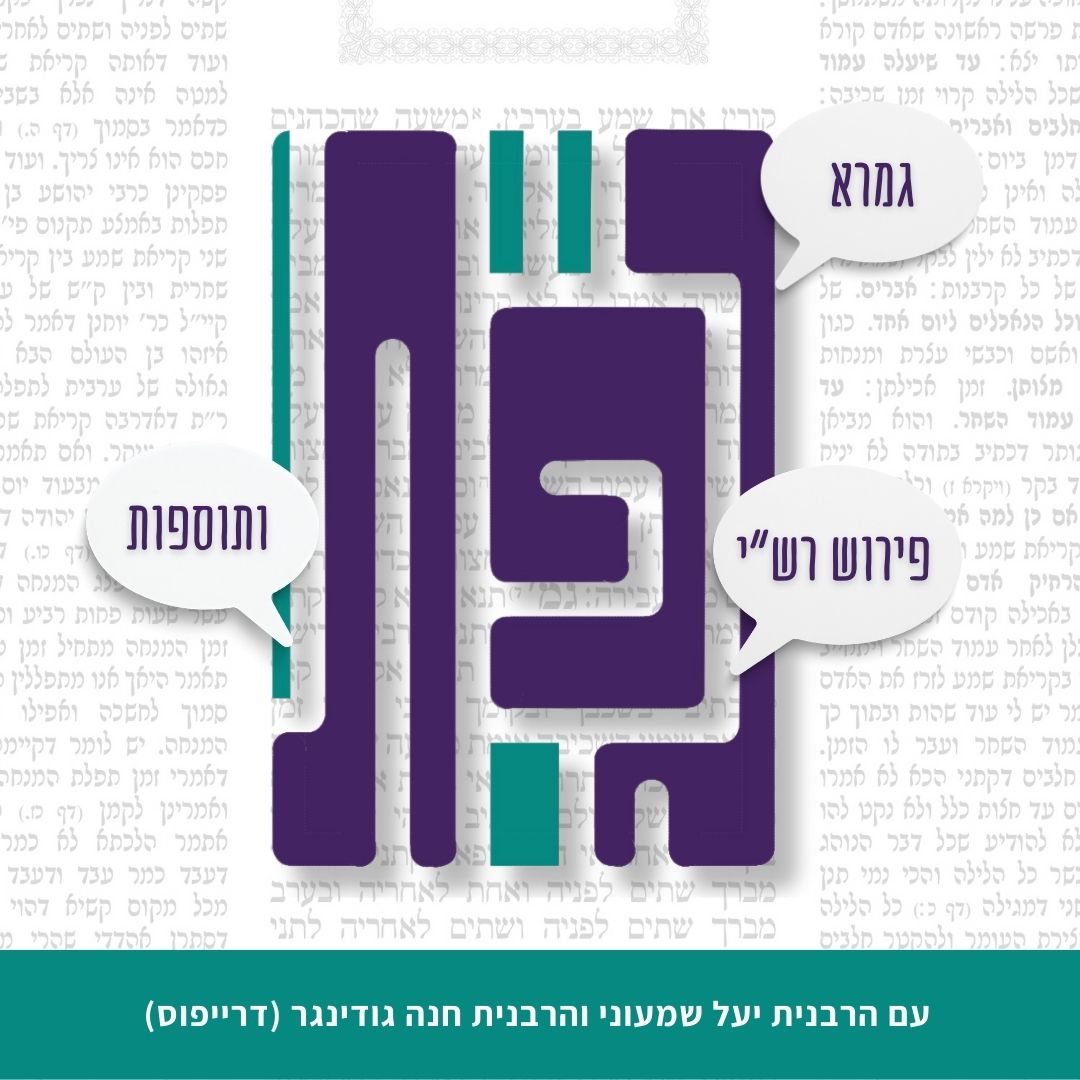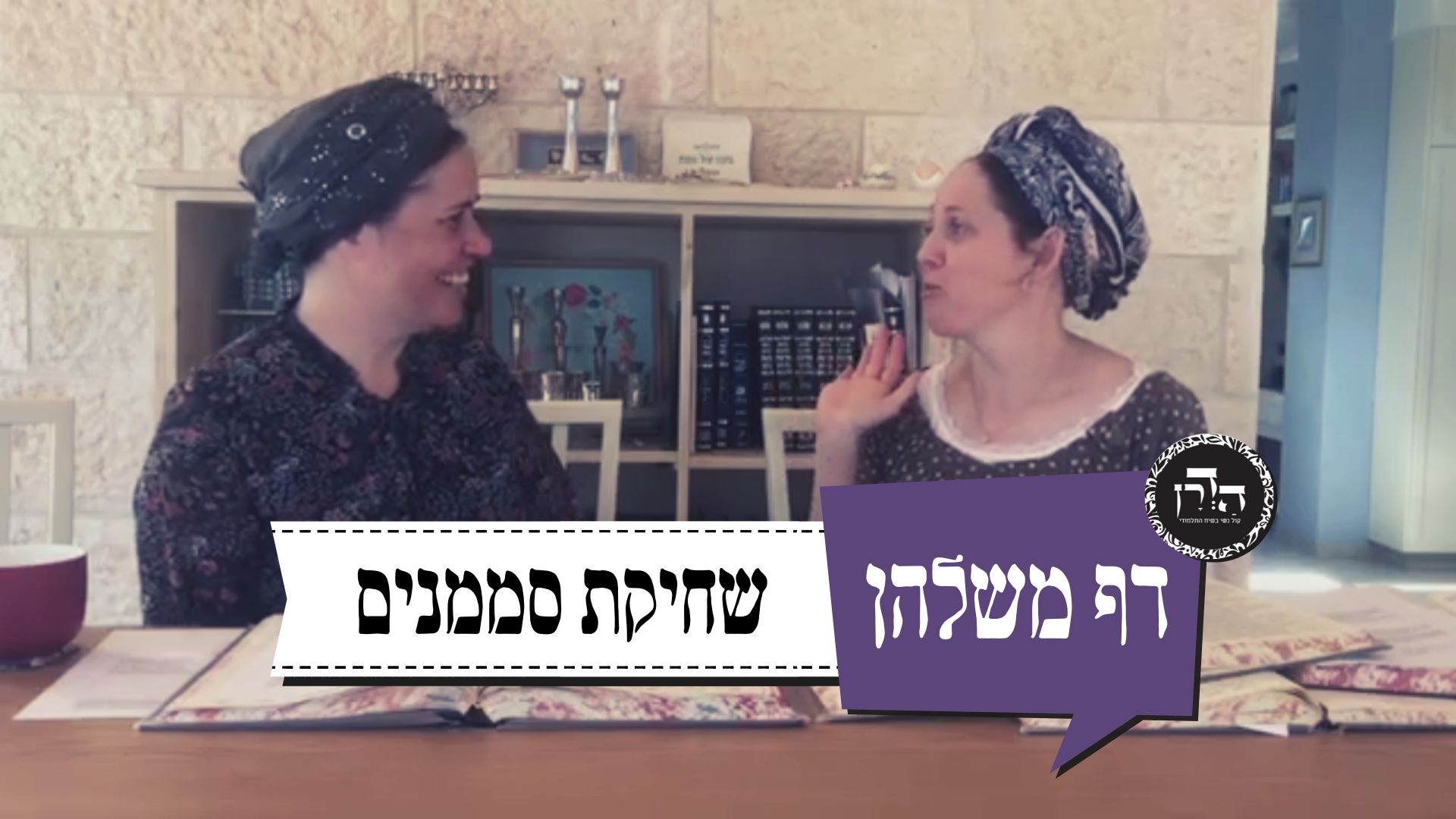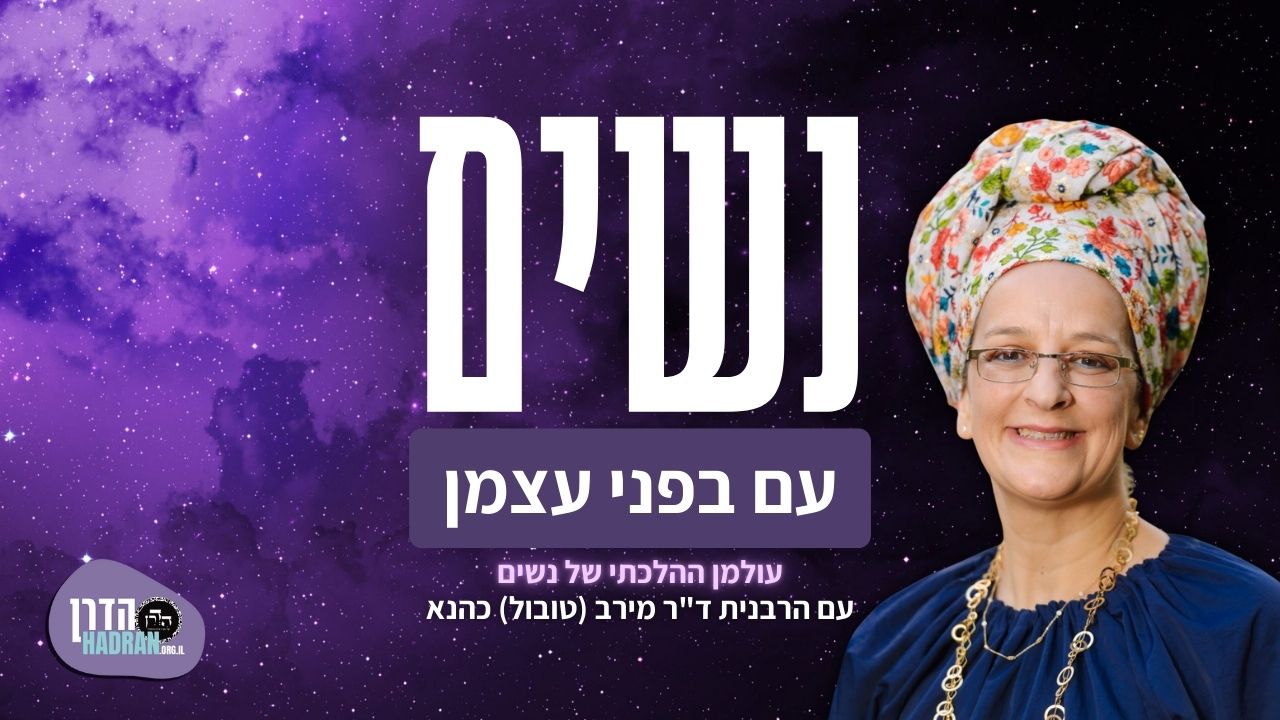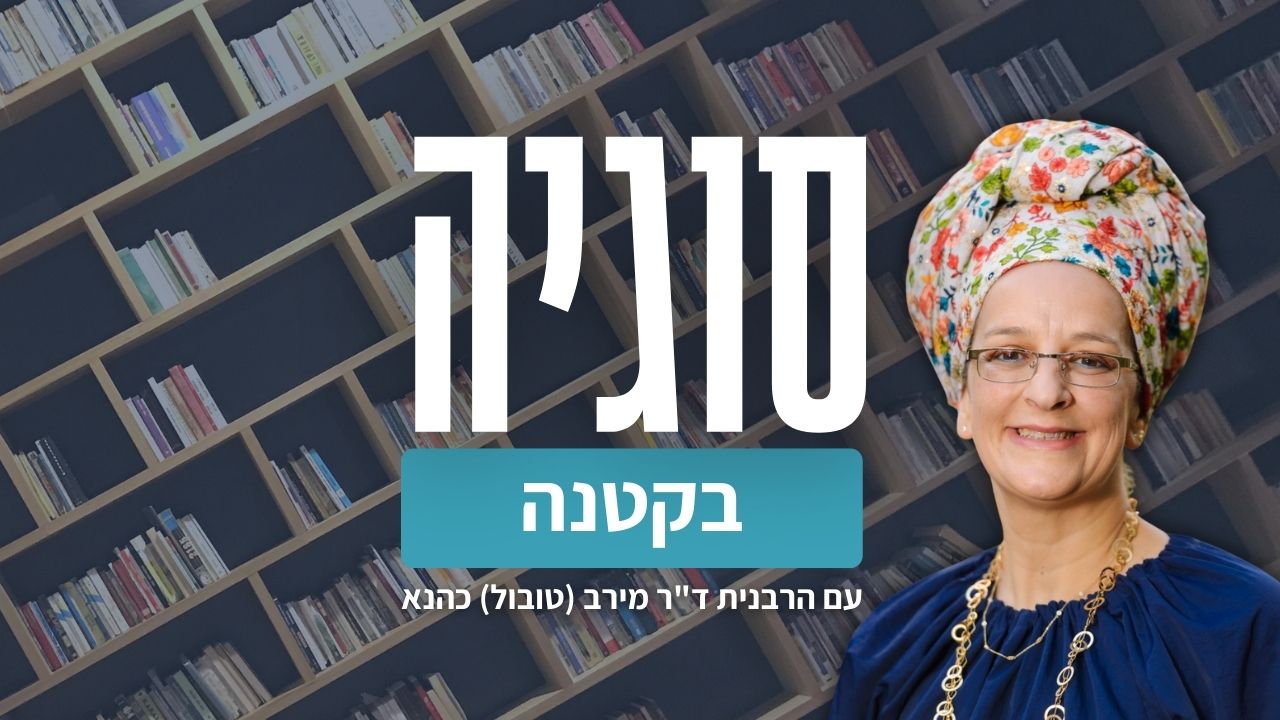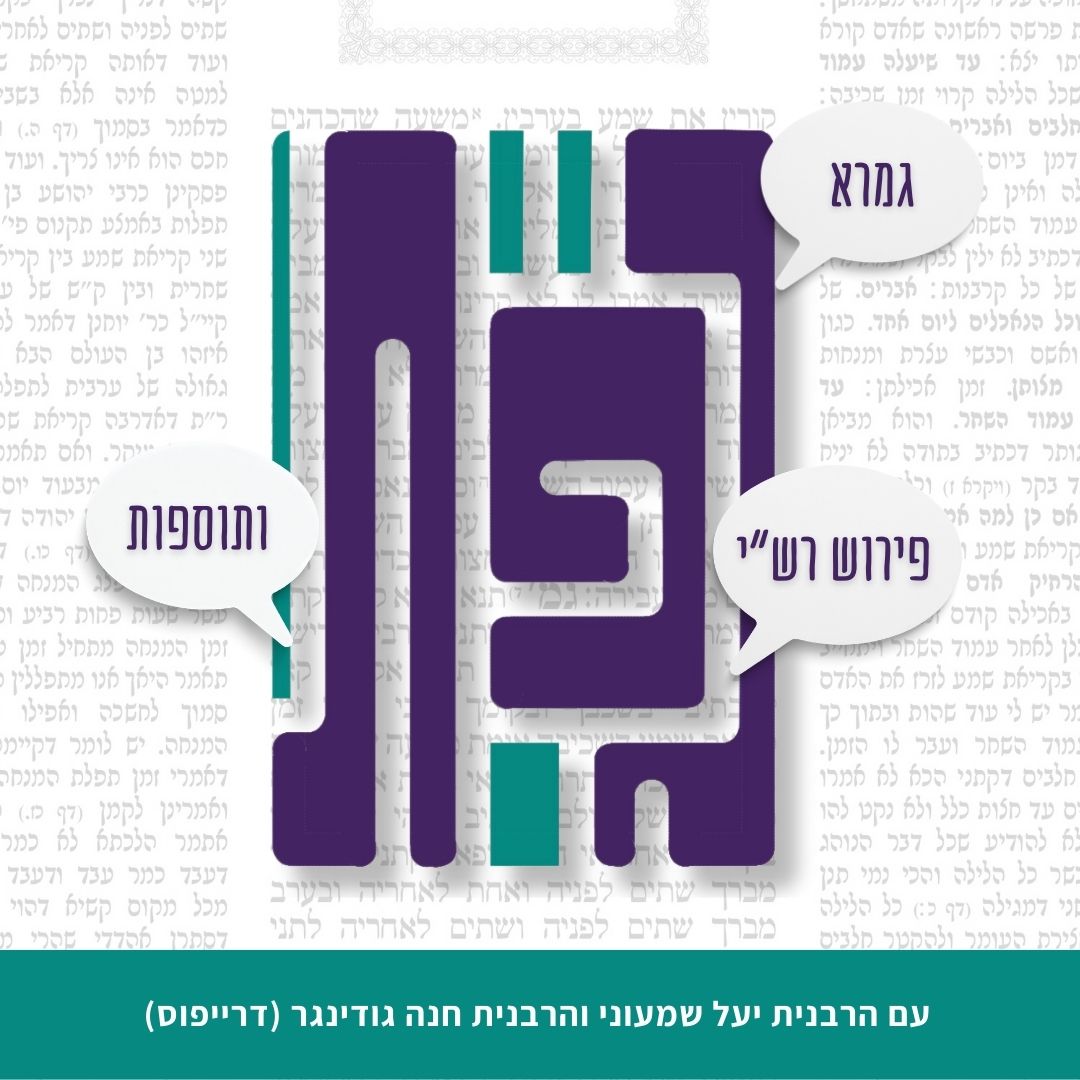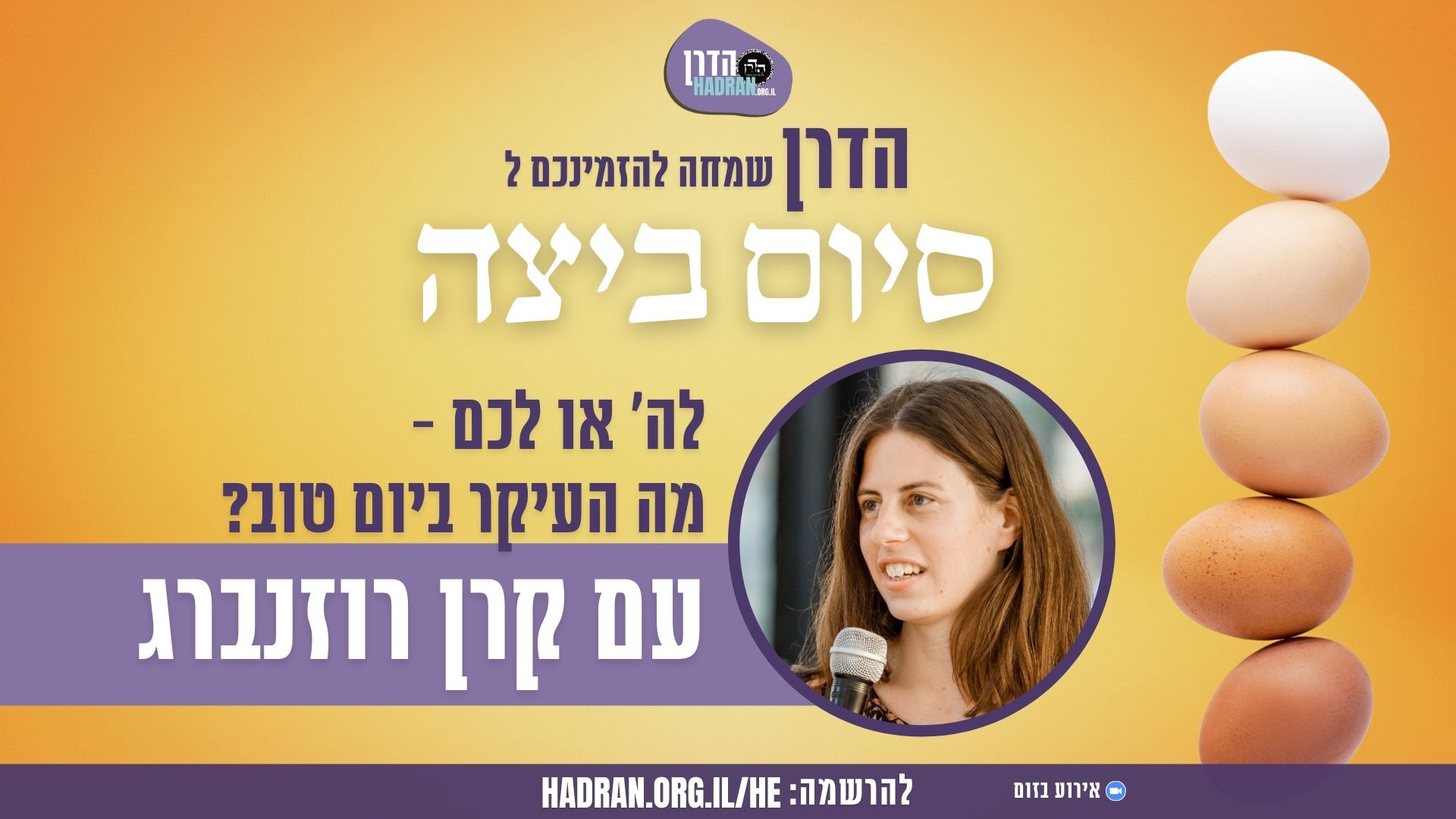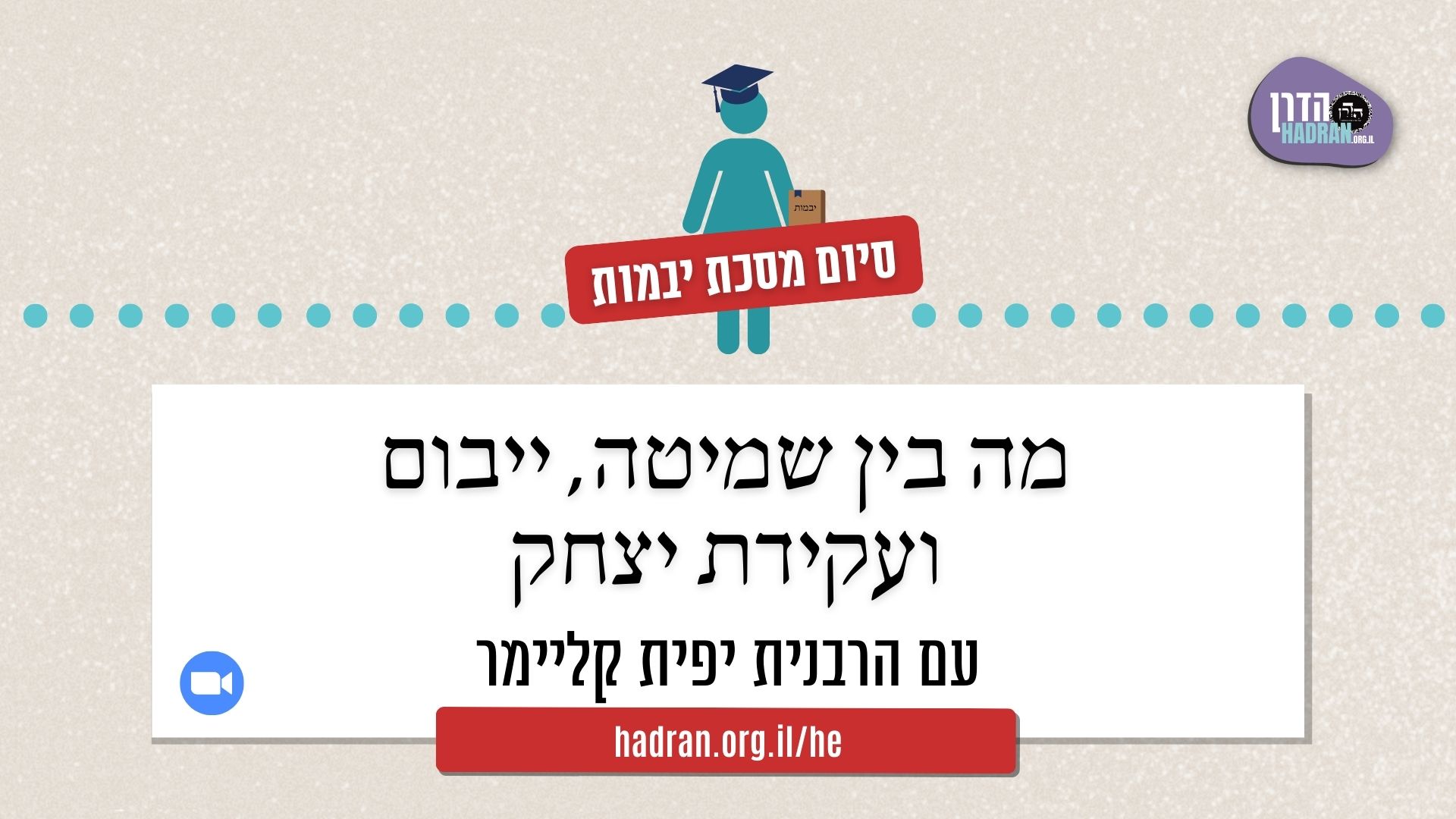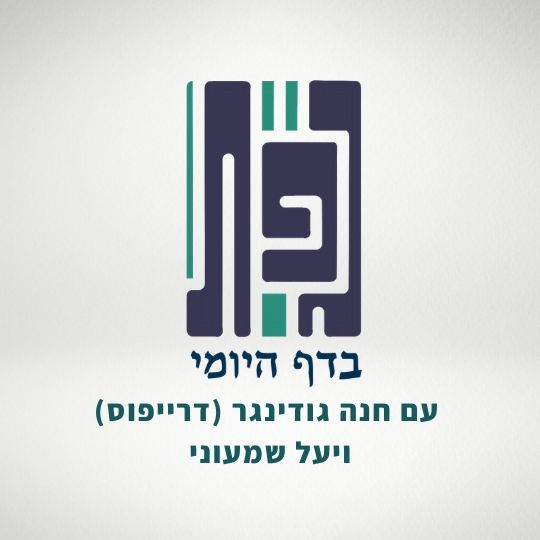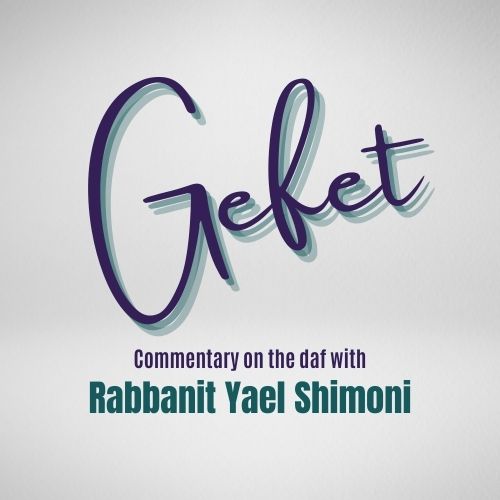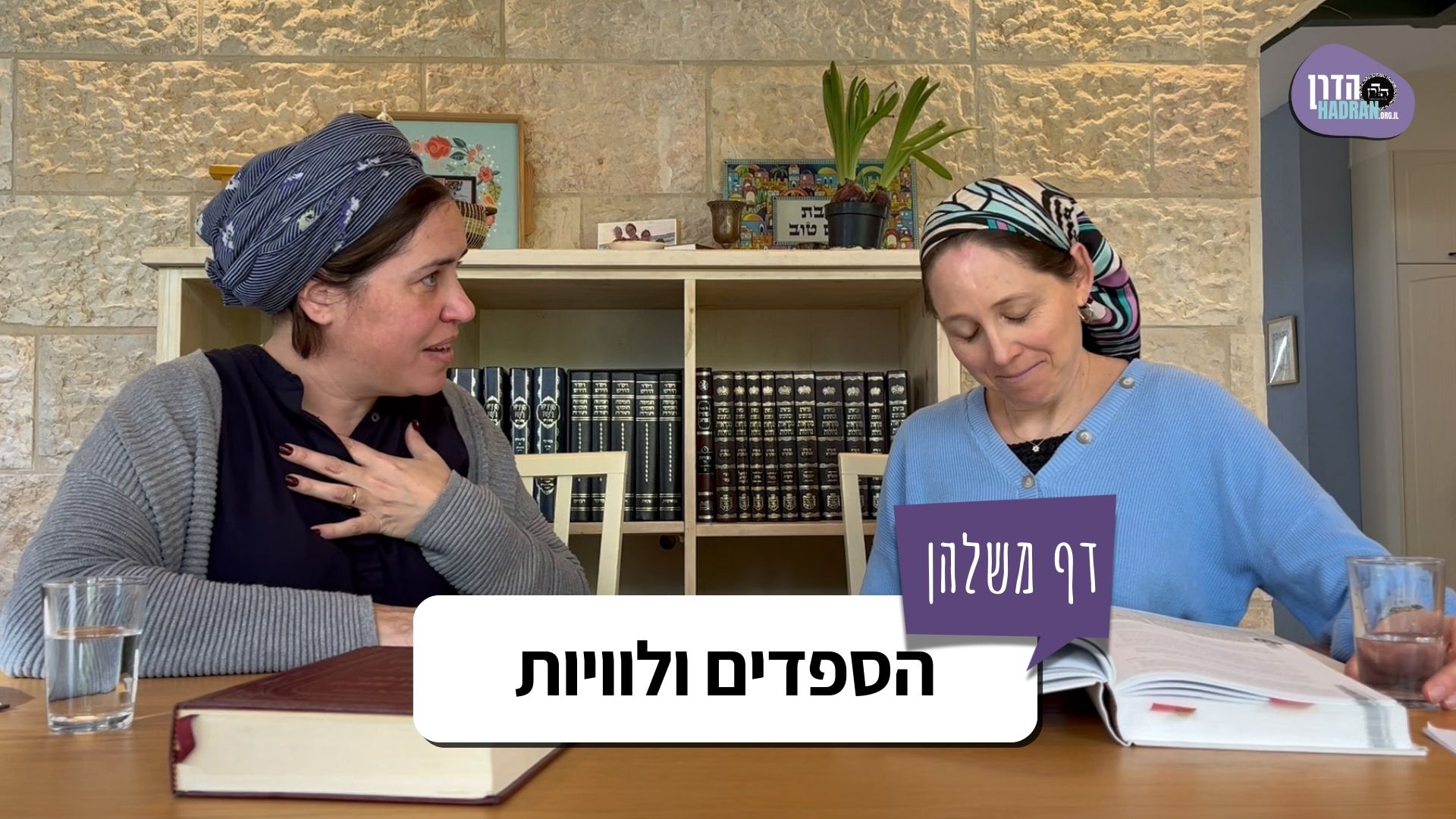באיזה עניינים הקשורים לבכור חושדים בכהנים ובאיזה מקרים לא חושדים בהם? ר’יהושע ורבן גמליאל חלקו בעניין אם כהן חבר חשוד על הטלת מום בבכור או לא – והויכוח הגיע למצב שרבן גמליאל בייש את ר’ יהושע ברבים.
הלימוד השבוע מוקדש ע”י אודרי מנדרו לע”נ יחזקאל בן רחל ואברהם.
הלימוד השבוע מוקדש ע”י קרוליין בולג לע”נ פנחס בן מנשה פייזר.
רוצה להקדיש שיעור?

כלים
הלימוד השבוע מוקדש ע”י אודרי מנדרו לע”נ יחזקאל בן רחל ואברהם.
הלימוד השבוע מוקדש ע”י קרוליין בולג לע”נ פנחס בן מנשה פייזר.
כלים
העמקה
רוצה להבין מה באמת קורה מתחת לפני השטח של הסוגיה?
שיעורים, פודקאסטים והרחבות של מיטב המורות שלנו יפתחו לך עוד זוויות וכיווני חשיבה.
חדשה בלימוד הגמרא?
זה הדף הראשון שלך? איזו התרגשות עצומה! יש לנו בדיוק את התכנים והכלים שיעזרו לך לעשות את הצעדים הראשונים ללמידה בקצב וברמה שלך, כך תוכלי להרגיש בנוח גם בתוך הסוגיות המורכבות ומאתגרות.
פסיפס הלומדות שלנו
גלי את קהילת הלומדות שלנו, מגוון נשים, רקעים וסיפורים. כולן חלק מתנועה ומסע מרגש ועוצמתי.
בכורות לו
אֵימַר דְּאָמַר רַבִּי מֵאִיר לַחֲשָׁשָׁא, לְאַחְזוֹקִינְהוּ מִי אָמַר?
The Gemara answers: One can say that Rabbi Meir says that priests are suspect with regard to causing blemishes only to the extent that there is a concern that they might have caused a blemish. But did he say this ruling to establish them as those who definitely cause blemishes? Certainly not.
אִיבַּעְיָא לְהוּ: עֵד מִפִּי עֵד, מַהוּ לְעֵדוּת בְּכוֹר? רַב אַסִּי אָסַר, וְרַב אָשֵׁי שָׁרֵי. אֲמַר לֵיהּ רַב אַסִּי לְרַב אָשֵׁי: וְהָא תָּנָא דְבֵי מְנַשֶּׁה: אֵין עֵד מִפִּי עֵד כָּשֵׁר אֶלָּא לְעֵדוּת הָאִשָּׁה!
§ A dilemma was raised before the Sages: With regard to testimony based on hearsay, where one repeats the testimony of another witness, what is the halakha in a case of such testimony about a blemished firstborn animal? Rav Asi deems prohibited the slaughter of the animal based on such testimony, and Rav Ashi deems it permitted. Rav Asi said to Rav Ashi: But isn’t it taught in a baraita in the school of Menashe that hearsay testimony is valid only for the testimony of a woman, where one testifies that her husband is dead? This indicates that such testimony is not accepted in all other instances.
תְּנִי: אֶלָּא לְעֵדוּת שֶׁהָאִשָּׁה כְּשֵׁרָה לָהּ בִּלְבָד.
Rav Ashi responded: Emend the baraita and teach it like this: Testimony based on hearsay is valid only for that testimony for which the testimony of a woman is valid. According to Rav Ashi, the baraita is teaching that any case where the testimony of a woman is valid, hearsay testimony is valid as well, and this includes testimony concerning a blemished firstborn animal.
רַב יֵימַר אַכְשַׁר עֵד מִפִּי עֵד בִּבְכוֹר, קָרֵי עֲלֵיהּ מָרִימָר: ״יֵימַר שָׁרֵי בּוּכְרָא״. וְהִלְכְתָא: עֵד מִפִּי עֵד כָּשֵׁר לְעֵדוּת בְּכוֹר.
The Gemara relates that Rav Yeimar deemed fit testimony based on hearsay with regard to a blemished firstborn animal. Mareimar condescendingly called him: Yeimar who permits firstborn animals. The Gemara concludes: And the halakha is that testimony based on hearsay is valid in the case of a firstborn animal.
אָמַר רַבִּי אִילְעָא: לֹא הָיוּ מוּחְזָקִין בּוֹ שֶׁהוּא בְּכוֹר, וּבָא אֶחָד וְאָמַר שֶׁהוּא בְּכוֹר וּמוּמוֹ עִמּוֹ — נֶאֱמָן.
§ The Gemara discusses a related matter. Rabbi Ile’a says: In a case where a blemished animal was not established as being a firstborn, and one priest came to an expert and said that it is a firstborn animal and yet its blemish is with it, i.e., it was unintentionally blemished, he is deemed credible, and the expert may deem the animal fit for slaughter based on the priest’s testimony.
מַאי קָא מַשְׁמַע לַן, שֶׁהַפֶּה שֶׁאָסַר הוּא הַפֶּה שֶׁהִתִּיר? תְּנֵינָא: הָאִשָּׁה שֶׁאָמְרָה ״אֵשֶׁת אִישׁ הָיִיתִי וּגְרוּשָׁה אֲנִי״ נֶאֱמֶנֶת, שֶׁהַפֶּה שֶׁאָסַר הוּא הַפֶּה שֶׁהִתִּיר!
The Gemara asks: What is Rabbi Ile’a teaching us? Is he teaching us the principle that the mouth that prohibited it is the mouth that permitted it, i.e., when the only source that an item was prohibited is the statement of one who says that it is now permitted, his claim is accepted? But we learn this in a mishna (Ketubot 22a): With regard to a woman who said: I was a married woman and now I am a divorcée, she is deemed credible and permitted to remarry, as the mouth that prohibited her by establishing that she was married is the mouth that permitted her by establishing that she was divorced.
מַהוּ דְּתֵימָא: הָתָם הוּא דְּאִי בָּעֲיָא לָא אָמְרָה. אֲבָל הָכָא, דְּלָא סַגִּיא דְּלָא אָמְרָה, דְּקָדָשִׁים בְּחוּץ לָא אָכֵיל,
The Gemara answers: Rabbi Ile’a’s statement is necessary, lest you say it is only there, in the case of the mishna, that the woman’s testimony is accepted, as, if she wants to remarry illegally, she does not need to say anything at all about previously being married. But here, with regard to the firstborn animal, it is different, as, if the priest wishes to eat the meat of the animal, it not sufficient for him not to bring the animal to an expert, i.e., he has no recourse other than to say that it is a firstborn animal which has a blemish requiring examination, as he cannot determine on his own whether this blemish permanently disqualifies the firstborn animal from sacrifice, and he would not eat sacrificial meat outside the Temple courtyard, which is punishable by karet.
אֵימָא: לָא הַפֶּה שֶׁאָסַר הוּא, קָא מַשְׁמַע לַן, דְּאִי מִשּׁוּם הָכִי — הֲוָה שָׁדֵי בֵּיהּ מוּמָא דְּנִיכָּר וְאָכֵיל לֵיהּ.
Since the priest must admit that this is a firstborn animal, I might say that this is not a case of: The mouth that prohibited it is the mouth that permitted it, and therefore the priest is not deemed credible. To dispel this possibility, Rabbi Ile’a teaches us that he is deemed credible, because if it due to that reason, that the priest is suspected of causing the blemish, he would have caused a blemish that is obvious to all. In such a case, he would violate a mere prohibition, not one that is punishable by karet, since he would not be eating sacrificial meat outside the Temple courtyard, as the animal is blemished.
מַתְקֵיף לַהּ מָר בַּר רַב אָשֵׁי: מַאי שְׁנָא מֵהָהוּא גַּבְרָא דְּאוֹגַר לֵיהּ חֲמָרָא לְחַבְרֵיהּ, וַאֲמַר לֵיהּ: לָא תֵּיזִיל בְּאוֹרְחָא דִּנְהַר פְּקוֹד דְּאִיכָּא מַיָּא, זִיל בְּאוֹרְחָא דְּנַרֶשׁ דְּלֵיכָּא מַיָּא. אֲזַל בְּאוֹרְחָא דִּנְהַר פְּקוֹד וּמִית חֲמָרָא, וַאֲתָא וַאֲמַר לֵיהּ: בְּאוֹרְחָא דִּנְהַר פְּקוֹד אָזְלִי, וּמִיהוּ מַיָּא לָא הֲווֹ.
Mar bar Rav Ashi objects to this: What is different between this case and that incident involving a certain man who rented a donkey to another? The owner said to the renter: Look, do not go on the path of Nehar Pekod, where there is water and the donkey is likely to drown. Instead, go on the path of Neresh, where there is no water. The renter went on the path of Nehar Pekod and the donkey died. When he came back, he said: Yes, I went on the path of Nehar Pekod, but there was no water there, and therefore the donkey’s death was caused by other factors.
וַאֲמַר רָבָא: מָה לוֹ לְשַׁקֵּר, אִי בָּעֵי אָמַר: בְּאוֹרְחָא דְּנַרֶשׁ אֲזַלִי. וַאֲמַר אַבָּיֵי: ״מָה לוֹ לְשַׁקֵּר״ בִּמְקוֹם עֵדִים לָא אָמְרִינַן.
And Rava said: The renter’s claim is accepted, due to the reasoning of: Why would he lie and state this claim? In other words, if this man wanted to lie, he could have told the donkey’s owner: I went on the path of Neresh, as the owner instructed. And Abaye said to Rava: We do not say the principle of: Why would he lie, in a place where there are witnesses. Since witnesses can be summoned to establish conclusively whether there was water along the path of Nehar Pekod, the reasoning that the renter could have stated a different claim is not employed. Similarly, the priest’s contention that the blemish occurred inadvertently should not be deemed credible, as it is known that priests are suspected of causing blemishes.
הָכִי הַשְׁתָּא?! הָתָם וַדַּאי אִיכָּא מַיָּא, הָכָא וַדַּאי שָׁדֵי בֵּיהּ מוּמָא — חֲשָׁשָׁא הוּא, וּבִמְקוֹם חֲשָׁשָׁא אָמְרִינַן ״מָה לוֹ לְשַׁקֵּר״. יָתֵיב רָבִינָא וְקָאָמַר לְהַאי שְׁמַעְתָּא בְּלָא גַּבְרָא, אֲמַר לֵיהּ רָבָא זוּטֵי לְרָבִינָא: אֲנַן מִשְּׁמֵיהּ דְּרַבִּי אִילְעָא מַתְנִינַן לַהּ.
The Gemara rejects this suggestion: How can these cases be compared? There, with regard to the path of Nehar Pekod, there is certainly water there, but here, the possibility that the priest caused a blemish in the firstborn animal is only a concern, and in a place of mere concern we do say the reasoning of: Why would he lie? The Gemara relates that Ravina was sitting and saying this halakha of Rabbi Ile’a anonymously. Rava Zuti said to Ravina: We learned this halakha in the name of Rabbi Ile’a.
רַבִּי צָדוֹק הֲוָה לֵיהּ בּוּכְרָא, רְמָא לֵיהּ שְׂעָרֵי בְּסַלֵּי, בַּהֲדֵי דְּקָאָכֵיל אִיבְּזַע שִׂיפְתֵּיהּ. אֲתָא לְקַמֵּיהּ דְּרַבִּי יְהוֹשֻׁעַ, אָמַר לוֹ: כְּלוּם חִילַּקְנוּ בֵּין חָבֵר לְעַם הָאָרֶץ? אָמַר לוֹ רַבִּי יְהוֹשֻׁעַ: הֵן.
§ The Gemara relates: Rabbi Tzadok, an erudite priest, had a firstborn animal. He placed barley in wicker baskets for it, and while it was eating, its lip split, rendering the animal blemished. Rabbi Tzadok came before Rabbi Yehoshua, to ask whether or not he is suspected of intentionally causing a blemish in his firstborn animal offering. Rabbi Tzadok said to him: Didn’t we differentiate between a priest who is a ḥaver, i.e., learned, and a priest who is an ignoramus, with regard to their credibility about blemishes found on a firstborn animal? Rabbi Yehoshua said to him: Yes, we did. Since you are a learned priest, you are deemed credible to testify that this blemish was caused inadvertently.
אֲתָא לְקַמֵּיהּ דְּרַבָּן גַּמְלִיאֵל, אָמַר לוֹ: חִילַּקְנוּ בֵּין חָבֵר לְעַם הָאָרֶץ? אָמַר לוֹ רַבָּן גַּמְלִיאֵל: לָא. אָמַר לוֹ: (והא) [וַהֲלֹא] רַבִּי יְהוֹשֻׁעַ אָמַר לִי הֵן! אָמַר לוֹ: הַמְתֵּן עַד שֶׁיַּעֲלוּ בַּעֲלֵי תְרִיסִין לְבֵית הַמִּדְרָשׁ.
Rabbi Tzadok then came before Rabban Gamliel, the Nasi and head of the academy of Yavne at the time. Rabbi Tzadok said to him: Didn’t we differentiate between a priest who is a ḥaver and a priest who is an ignoramus with regard to credibility about blemishes found on a firstborn animal? Rabban Gamliel said to him: No, we did not. Rabbi Tzadok said to him: But Rabbi Yehoshua said to me that yes, we did differentiate in this manner. Rabban Gamliel said to Rabbi Tzadok: Wait until the masters of the shields [ba’alei terisin], a reference to the Torah scholars who battle in the war of Torah, enter the study hall, at which point we will discuss this issue.
כֵּיוָן שֶׁנִּכְנְסוּ לְבֵית הַמִּדְרָשׁ, עָמַד הַשּׁוֹאֵל וְשָׁאַל: כְּלוּם חִילַּקְנוּ בֵּין חָבֵר לְעַם הָאָרֶץ? אָמַר לוֹ רַבִּי יְהוֹשֻׁעַ: לָאו. אָמַר לוֹ רַבָּן גַּמְלִיאֵל: וַהֲלֹא מִשִּׁמְךָ אָמְרוּ לִי הֵן!
When the Torah scholars entered the study hall, the questioner stood before everyone present and asked: With regard to blemishes found on a firstborn animal, didn’t we differentiate between a priest who is a ḥaver and a priest who is an ignoramus? Rabbi Yehoshua said to him: No, we did not. Rabban Gamliel said to him: But they said to me in your name that yes, we did differentiate.
יְהוֹשֻׁעַ, עֲמוֹד עַל רַגְלֶיךָ, וְיָעִידוּ בְּךָ. עָמַד רַבִּי יְהוֹשֻׁעַ עַל רַגְלָיו וְאָמַר: הֵיאַךְ אֶעֱשֶׂה? אִילְמָלֵי אֲנִי חַי וְהוּא מֵת — יָכוֹל הַחַי לְהַכְחִישׁ אֶת הַמֵּת, עַכְשָׁיו שֶׁאֲנִי חַי וְהוּא חַי — הֵיאַךְ חַי יָכוֹל לְהַכְחִישׁ אֶת הַחַי?
Rabban Gamliel continued: Yehoshua, stand on your feet and they will testify against you that you did, in fact, say that we differentiated in such a case. Rabbi Yehoshua stood on his feet and said: How should I act in this situation? If I were alive and Rabbi Tzadok were dead, the living can contradict the dead, and I could deny issuing that ruling. Now that I am alive and he is alive, how can the living contradict the living? I have no choice but to admit that I said it.
וְהָיָה רַבָּן גַּמְלִיאֵל עוֹמֵד וְדוֹרֵשׁ, וְרַבִּי יְהוֹשֻׁעַ עוֹמֵד עַל רַגְלָיו, עַד שֶׁרִינְּנוּ כׇּל הָעָם וְאָמְרוּ לְחוּצְפִּית הַמְתוּרְגְּמָן: עֲמוֹד! וְעָמַד.
In the meantime, Rabban Gamliel was standing and lecturing, and Rabbi Yehoshua all the while was standing on his feet, as Rabban Gamliel did not instruct him to sit. He remained standing in deference to the Nasi. This continued for some time, until it aroused great resentment against Rabban Gamliel, and all of the people assembled began murmuring and said to Ḥutzpit the disseminator: Stop conveying Rabban Gamliel’s lecture, and he stopped.
מַתְנִי׳ נֶאֱמָן הַכֹּהֵן לוֹמַר: הֶרְאֵיתִי בְּכוֹר זֶה וּבַעַל מוּם הוּא.
MISHNA: A priest is deemed credible to say: I showed this firstborn animal to an expert and he ruled that it is blemished.
גְּמָ׳ אָמַר רַב יְהוּדָה אָמַר רַב: נֶאֱמָן הַכֹּהֵן לוֹמַר ״בְּכוֹר זֶה נָתַן לִי יִשְׂרָאֵל בְּמוּמוֹ״. מַאי טַעְמָא? כֹּל מִילְּתָא דַּעֲבִידָא לְאִיגַּלּוֹיֵי לָא מְשַׁקְּרִי בַּהּ אִינָשֵׁי. אָמַר רַב אָשֵׁי: אַף אֲנַן נָמֵי תְּנֵינָא, נֶאֱמָן הַכֹּהֵן לוֹמַר ״הֶרְאֵיתִי בְּכוֹר זֶה וּבַעַל מוּם הוּא״. מַאי טַעְמָא? לָאו מִשּׁוּם דְּאָמְרִינַן כֹּל מִילְּתָא דַּעֲבִידָא לְאִיגַּלּוֹיֵי לָא מְשַׁקְּרִי בַּהּ אִינָשֵׁי?
GEMARA: Rav Yehuda says that Rav says: A priest is deemed credible to say: An Israelite gave me this firstborn animal with its blemish already inflicted upon it. What is the reason? With regard to any matter that is likely to be revealed, people do not lie about it. Since the Israelite can be questioned with regard to the veracity of the priest’s claim, it is assumed that the priest will not risk lying. Rav Ashi said: We learn a similar principle in the mishna as well: A priest is deemed credible to say: I showed this firstborn animal to an expert and he ruled that it is blemished. What is the reason the priest’s claim is deemed credible? Is it not because we say that with regard to any matter that is likely to be revealed, people do not lie about it?
הָתָם הוּא דְּקָדָשִׁים בְּחוּץ לָא אָכֵיל, אֲבָל הָכָא, כֵּיוָן דַּחֲשִׁידִי — חֲשִׁידִי.
The Gemara rejects the claim that the mishna’s ruling is based on the principle that people do not lie about a matter that is likely to be revealed: Perhaps there, in the case of the mishna, the reason the priest’s claim is accepted is that he would not eat sacrificial meat outside the Temple courtyard. If an expert had not permitted the meat, the priest would not eat it. But here, in Rav’s case, where the priest claims an Israelite gave him an already blemished animal, since priests are suspected of causing blemishes and claiming that it was inadvertent, they are also suspected of causing a blemish and claiming it was given to them in that state by an Israelite.
מֵתִיב רַב שֵׁיזְבִי: הָאוֹמֵר לְמִי שֶׁאֵין נֶאֱמָן עַל הַמַּעֲשֵׂר ״קַח לִי מִמִּי שֶׁהוּא נֶאֱמָן״ אוֹ ״מִמִּי שֶׁהוּא מְעַשֵּׂר״ — אֵינוֹ נֶאֱמָן. אַמַּאי? נֵימָא: כֹּל מִילְּתָא דַּעֲבִידָא לְאִיגַּלּוֹיֵי לָא מְשַׁקְּרִי בַּהּ אִינָשֵׁי!
Rav Sheizevi raises an objection to Rav’s ruling from a mishna (Demai 4:5): In the case of one who says to someone who is not trusted with regard to tithe: Purchase produce for me from someone who is trusted with regard to tithes, i.e., one who does not purchase produce from an ignoramus, who generally does not separate tithes; or if he says: Purchase produce for me from someone who tithes, i.e., even from one who purchases produce from an ignoramus but is careful to set aside tithes upon purchasing the produce, the agent is not deemed credible to claim that he fulfilled the condition of the one who appointed him. According to Rav, why isn’t the agent deemed credible? Say the principle that with regard to any matter that is likely to be revealed, people do not lie about it.
שָׁאנֵי הָתָם,
The Gemara answers: It is different there,
דְּאִית לֵיהּ לְאִשְׁתְּמוֹטֵי.
as he has the easy option of extricating himself from the accusation that he did not fulfill the condition of the one who appointed him, by claiming that in his opinion the individual from whom he purchased the produce was to be trusted. Since the issue of the third party’s trustworthiness is subjective, the agent is not afraid to lie.
סֵיפָא וַדַּאי מְסַיְּיעָא לֵיהּ: מֵאִישׁ פְּלוֹנִי — הֲרֵי זֶה נֶאֱמָן.
The Gemara suggests: The latter clause of this mishna certainly supports the ruling of Rav, that people do not lie with regard to any matter that will be revealed. How so? The latter clause states that if the one instructed the agent to purchase produce specifically from so-and-so, who is reliable with regard to tithes, then this agent is deemed credible to claim that he adhered to the instructions. Since the one who appointed him mentioned a specific individual, the agent is not suspected of lying, as that individual can be subsequently questioned.
הָתָם, כֵּיוָן דְּאִית לֵיהּ תּוֹבֵעַ, מִירְתַת.
The Gemara rejects this proof: There, in the mishna, since the agent has a claimant, he is afraid to lie. In other words, since the one who appointed him specified an individual, the agent presumes that he intends to verify the matter, and therefore he will not risk lying. By contrast, in Rav’s case, since it was the priest who volunteered the information that a specific Israelite gave him an already blemished firstborn animal, he is not concerned that the examiner might seek out the Israelite to confirm the actual facts.
אָמַר רַבִּי יִרְמְיָה בַּר אַבָּא: מְנָא לֵיהּ לִיהוּדָה הָא? אֲנָא בְּגִידּוּל קְבַעְתָּיהּ, וְגִידּוּל קְבַע בְּדִידֵיהּ. וְהָכִי אָמְרִי לֵיהּ: נֶאֱמָן יִשְׂרָאֵל לוֹמַר ״בְּכוֹר זֶה נָתַתִּי לְכֹהֵן בְּמוּמוֹ״.
Upon hearing Rav Yehuda’s statement in the name of Rav, Rabbi Yirmeya bar Abba said: From where does Yehuda know this halakha? Actually, I taught this halakha to Giddul in Rav’s name and Giddul, in turn, taught it to Rabbi Yehuda. But Giddul corrupted my statement, as this is how I said it to him: An Israelite is deemed credible to say: I gave this firstborn animal to a priest with its blemish already inflicted upon it, and it may be slaughtered and eaten.
יִשְׂרָאֵל? פְּשִׁיטָא! לָא צְרִיכָא בְּקָטָן וְהִגְדִּיל, מַהוּ דְּתֵימָא: לָא קִים לֵיהּ? קָא מַשְׁמַע לַן.
The Gemara asks: An Israelite? It is obvious that he is deemed credible to issue this claim, as he has no use for the firstborn animal. The Gemara answers: No, this ruling is necessary, as it is referring to an animal that was young when the Israelite gave it to the priest and it grew older by the time of his testimony. This ruling is necessary, lest you say that as the animal grew older in the interim, perhaps the Israelite does not recognize it and mistakenly assumes that it was the animal he gave the priest, when in fact it is a different firstborn animal upon which the priest intentionally caused a blemish. Rabbi Yirmeya bar Abba therefore teaches us that the Israelite is trusted to recognize the animal he gave the priest.
בְּסוּרָא מַתְנוּ כְּלִשָּׁנָא בָתְרָא, בְּפוּמְבְּדִיתָא כְּלִשָּׁנָא קַמָּא, וְהִלְכְתָא אֲפִילּוּ כְּלִשָּׁנָא קַמָּא.
The Gemara notes: In Sura, they teach the halakha in accordance with the latter version, as stated by Rabbi Yirmeya bar Abba, that an Israelite is deemed credible to testify. In Pumbedita, they teach the halakha in accordance with the first version, as taught by Rav Yehuda, citing Rav, that even a priest is deemed credible if he claims that an Israelite gave him an already blemished firstborn animal. The Gemara concludes: And the halakha is in accordance with even the first version.
רַפְרָם בְּפוּמְבְּדִיתָא הֲוָה לֵיהּ בּוּכְרָא, וְיַהֲבֵיהּ לֵיהּ לְכֹהֵן בְּלָא מוּמָא. אֲזַל שְׁדָא בֵּיהּ מוּמָא. יוֹמָא חַד חֲלַשׁ בְּעֵינֵיהּ, אַיְיתְיֵהּ לְקַמֵּיהּ. אֲמַר לֵיהּ: בְּכוֹר זֶה נָתַן לִי יִשְׂרָאֵל בְּמוּמוֹ. אַרְפְּסִינֵיהּ לְעֵינֵיהּ, חַזְיֵיהּ בְּשִׁקְרֵיהּ. אֲמַר לֵיהּ: לָאו אֲנָא דִּיהֵיבְתֵּיהּ לָךְ?
In this regard, the Gemara relates that Rafram, who resided in Pumbedita, had a firstborn animal and he gave it to a priest in an unblemished state. The priest went and caused a blemish in it. One day, Rafram had an affliction in his eyes, which rendered it difficult for him to open them. The priest to whom Rafram had given the firstborn animal brought it before him, as an expert examiner, for him to deem the animal permitted. The priest said to him: An Israelite gave me this firstborn animal with its blemish upon it. Rafram forced his eyes open and saw the animal and recognized it [bashkerei] as the one he himself had given the priest. Rafram said to the priest: Is it not I who gave this firstborn animal to you?
וַאֲפִילּוּ הָכִי לָא חַשׁ לַהּ לְמִילְּתָא, הַאי הוּא דַּחֲצִיף, כּוּלֵּי עָלְמָא לָא חֲצִיפִי.
The Gemara notes: And even so, Rafram was unconcerned by the matter of the priest’s attempted chicanery, as he maintained that it is only this priest who is impudent, but all other priests are not impudent. This scenario did not cause Rafram to discredit any other priest’s claim that he received a blemished firstborn animal from an Israelite, as this was an exceptional case. This priest demonstrated extreme impudence by bringing it to be examined by Rafram himself, and therefore one cannot draw conclusions about the behavior of other priests from this incident.
הָהוּא שָׂרוּעַ דַּאֲתָא לְקַמֵּיהּ דְּרַב אָשֵׁי, אָמַר: לְמַאי נֵיחוּשׁ לֵיהּ? אִי כֹּהֵן הוּא, אִי יִשְׂרָאֵל הוּא — הֲרֵי בְּכוֹר וּמוּמוֹ עִמּוֹ.
§ The Gemara relates that there was a certain firstborn animal, one of whose eyes was larger than the other, whose owner came before Rav Ashi to have it deemed fit for slaughter on account of its blemish. Uncertain as to who brought the animal for examination, Rav Ashi said: For what should we be concerned with regard to this animal? In a case of such a blemish, whether it is a priest who brought it for examination, or whether it is an Israelite, there is no concern that the blemish might have been intentionally caused, as this is clearly a firstborn animal whose blemish was already with it naturally.
אֲמַר לֵיהּ רָבִינָא לְרַב אָשֵׁי: וְדִלְמָא יִשְׂרָאֵל הוּא, וְאָמַר רַב יְהוּדָה: אֵין רוֹאִין בְּכוֹר יִשְׂרָאֵל אֶלָּא אִם כֵּן כֹּהֵן עִמּוֹ!
Ravina said to Rav Ashi: But perhaps it is an Israelite who brought the firstborn animal, and Rav Yehuda says that one may not examine the firstborn animal of an Israelite unless a priest is present with him in order to receive the animal if it is established as fit for slaughter. Rav Yehuda is concerned that if the Israelite’s firstborn animal is deemed fit for slaughter when no priest is present, the Israelite might improperly use the animal for his own purposes. If so, how can you, Rav Ashi, say that there is no problem if this animal was brought by an Israelite?
אֲמַר לֵיהּ: הָכִי הַשְׁתָּא?! הָתָם, נְהִי דְּקָדָשִׁים בְּחוּץ לָא אָכֵיל, אַמָּמוֹנֵיהּ דְּכֹהֵן חֲשִׁיד.
Rav Ashi said to Ravina in response: How can these cases be compared? There, where the presence of a priest is required, it is referring to a case where the halakhic status of the blemish has yet to be determined. Now, granted an Israelite will not risk eating sacrificial meat outside the Temple courtyard, as that incurs a penalty of karet, and he therefore would have the blemish’s status determined by an expert. But he is suspected with regard to the property of a priest. Although the Israelite will have the status of the animal confirmed before risking a prohibition that entails karet, he might steal the firstborn offering if it is established as fit for consumption.
הָכָא, מִכְּדֵי יָדַע דְּהַאי מוּם מוּבְהָק הוּא, מַאי טַעְמָא אַתְיוּהּ קַמֵּיהּ רַבָּנַן? מִשּׁוּם כְּבוֹדוֹ דְּחָכָם; עַל כְּבוֹדוֹ דְּחָכָם לָא עָבֵיד, אִיסּוּרָא עָבֵד?!
Conversely, here, in the case of the animal that had one eye larger than the other, since even an Israelite knows that this is a clear-cut blemish and the animal is clearly fit for slaughter, what is the reason he brought the animal before the Sages for examination? He brought it out of respect for the Sage. Now, if this Israelite does not neglect the respect due a Sage, would he commit a transgression and steal the possession of the priest? Certainly not. Therefore, in our case an Israelite would be trustworthy, and the presence of a priest is unnecessary.
מַתְנִי׳ הַכֹּל נֶאֱמָנִין עַל מוּמֵי מַעֲשֵׂר.
MISHNA: Everyone is deemed credible to testify about the blemishes of an animal tithe offering, even the owner who is the beneficiary of a ruling that it is blemished.
גְּמָ׳ מַאי טַעְמָא? דְּאִי בָּעֵי שָׁדֵי בֵּיהּ מוּמָא מֵעִיקָּרָא! מִי יָדַע הֵי נָפֵיק?
GEMARA: What is the reason that even the owner is deemed credible to testify? The reason is that had he wanted, he could have caused a blemish in it initially, in a permitted manner, before tithing his animals. The Gemara raises a difficulty: But when he leads his animals out of the gate in order to tithe them, does he know which of them will emerge as the tenth, that you say he could have initially blemished that specific animal before it assumed the tithe status?
וְכִי תֵּימָא מַפֵּיק לֵיהּ בְּרֵישׁ עַשְׂרָה, ״לֹא יְבַקֵּר בֵּין טוֹב לָרַע״ אָמַר רַחֲמָנָא! אֶלָּא דְּאִי בָּעֵי שָׁדֵי בֵּיהּ מוּמָא (בכולי) [בְּכוּלֵּיהּ] עֶדְרֵיהּ.
And if you would say that he intentionally leads an animal out as the head of the ten, i.e., so that it is the last of ten to emerge, one may not do so, as the Merciful One states: “He shall not search whether it be good or bad” (Leviticus 27:33), which teaches that the animal tithe may not be led out intentionally but must exit of its own accord. Rather, this is the meaning of the Gemara’s initial answer: The reason is that had he wanted, he could have caused a blemish in his entire flock, in a permitted manner, before leading them through the gate in order to tithe them.
מַתְנִי׳ בְּכוֹר שֶׁנִּסְמֵית עֵינוֹ, וְשֶׁנִּקְטְעָה יָדוֹ, וְשֶׁנִּשְׁבְּרָה רַגְלוֹ — הֲרֵי זֶה יִשָּׁחֵט עַל פִּי שְׁלֹשָׁה בְּנֵי הַכְּנֶסֶת. רַבִּי יוֹסֵי אוֹמֵר: אֲפִילּוּ יֵשׁ שָׁם עֶשְׂרִים וּשְׁלֹשָׁה, אֵינוֹ נִשְׁחָט אֶלָּא עַל פִּי מוּמְחֶה.
MISHNA: With regard to a firstborn animal whose eye was blinded or whose foreleg was severed or whose hind leg was broken, all of which obviously render the animal permanently blemished, that animal may be slaughtered on the basis of the ruling of three regular Jews who attend the synagogue, and it does not require a ruling by one of the Sages. Rabbi Yosei disagrees and says: Even if there is a court of twenty-three Sages there, it may be slaughtered only on the basis of the ruling of an expert in judging blemishes.
גְּמָ׳ רַבִּי שִׂמְלַאי וְרַבִּי יְהוּדָה נְשִׂיאָה תַּרְוַיְיהוּ מִשְּׁמֵיהּ דְּרַבִּי יְהוֹשֻׁעַ בֶּן לֵוִי אָמְרִי, וְאָמְרִי לַהּ: רַבִּי שִׂמְלַאי וְרַבִּי יְהוֹשֻׁעַ בֶּן לֵוִי תַּרְוַיְיהוּ מִשּׁוּם רַבִּי יְהוּדָה נְשִׂיאָה אָמְרִי: הַתָּרַת בְּכוֹר בְּחוּצָה לָאָרֶץ עַל פִּי שְׁלֹשָׁה בְּנֵי הַכְּנֶסֶת. אָמַר רָבָא: וּבְמוּמִין מוּבְהָקִין.
GEMARA: The Gemara relates that Rabbi Simlai and Rabbi Yehuda Nesia both say in the name of Rabbi Yehoshua ben Levi, and some say that Rabbi Simlai and Rabbi Yehoshua ben Levi both say in the name of Rabbi Yehuda Nesia: The permitting of the slaughter of a firstborn animal outside of Eretz Yisrael, where a firstborn offering is unfit for sacrifice even when the Temple is standing, may be performed on the basis of the ruling of three regular Jews who attend the synagogue. Rava said: And this ruling applies specifically in a case of clear-cut blemishes, i.e., those blemishes which clearly permit the slaughter of the firstborn animal.
מַאי קָא מַשְׁמַע לַן? תְּנֵינָא: בְּכוֹר שֶׁנִּסְמֵית עֵינוֹ, וְשֶׁנִּקְטְעָה יָדוֹ, וְשֶׁנִּשְׁתַּבְּרָה רַגְלוֹ — הֲרֵי זֶה יִשָּׁחֵט עַל פִּי שְׁלֹשָׁה בְּנֵי הַכְּנֶסֶת!
The Gemara asks: What is Rava teaching us by this statement? We already learn this in the mishna: With regard to a firstborn animal whose eye was blinded or whose foreleg was severed or whose hind leg was broken, that animal may be slaughtered on the basis of the ruling of three regular Jews who attend the synagogue. The mishna is referring to clear-cut blemishes in contemporary times, in the absence of the Temple, when a firstborn animal is unfit to be brought as an offering. What, then, is the novelty of Rava’s statement?
אִי מִמַּתְנִיתִין הֲוָה אָמֵינָא: בְּחוּצָה לָאָרֶץ אֲפִילּוּ מוּמִין שֶׁאֵין מוּבְהָקִין, וְהַאי דְּקָתָנֵי מוּבְהָקִין — לְהוֹדִיעֲךָ כֹּחוֹ דְּרַבִּי יוֹסֵי, קָא מַשְׁמַע לַן.
The Gemara answers: If the halakha that three regular Jews may permit the slaughter of a firstborn animal is learned from the mishna alone, I would say that according to the mishna, the power invested in three regular Jews to permit the slaughter of a firstborn animal in the absence of the Temple nowadays, or outside of Eretz Yisrael during Temple times, applies even to a firstborn animal that has blemishes that are not clear-cut. And the reason that the mishna specifically teaches a case of clear-cut blemishes is to convey the far-reaching nature of the opinion of Rabbi Yosei, who requires the examination of an expert even in such a case. Rava therefore teaches us that this is not so; rather, the mishna’s ruling is referring specifically to a case of clear-cut blemishes.
אָמַר רַב יְהוּדָה אָמַר רַבִּי יִרְמְיָה בַּר אַבָּא, סָפֵק מִשְּׁמֵיהּ דְּרַב, סָפֵק מִשְּׁמֵיהּ דִּשְׁמוּאֵל: שְׁלֹשָׁה מַתִּירִין אֶת הַבְּכוֹר בִּמְקוֹם שֶׁאֵין מוּמְחֶה. מַאי קָא מַשְׁמַע לַן? תְּנֵינָא: הֲרֵי זֶה יִשָּׁחֵט עַל פִּי שְׁלֹשָׁה בְּנֵי הַכְּנֶסֶת!
§ Rav Yehuda says that Rabbi Yirmeya bar Abba says the following halakha, but he was uncertain whether Rabbi Yirmeya bar Abba said it in the name of Rav and uncertain whether he said it in the name of Shmuel: Three regular Jews may permit a firstborn animal with clear-cut blemishes in a place where there is no expert. The Gemara asks: What is Rav Yehuda teaching us by this statement? We already learn this in the mishna: That animal may be slaughtered on the basis of the ruling of three regular Jews who attend the synagogue.
אִי מִמַּתְנִיתִין הֲוָה אָמֵינָא: בִּמְקוֹם מוּמְחֶה, קָא מַשְׁמַע לַן: בִּמְקוֹם שֶׁאֵין מוּמְחֶה — אִין, בִּמְקוֹם שֶׁיֵּשׁ מוּמְחֶה — לָא.
The Gemara answers: If the halakha is learned from the mishna alone, I would say that three laymen may permit a firstborn animal with clear-cut blemishes even in a place where there is an expert. Rav Yehuda therefore teaches us that in a place where there is no expert, yes, three laymen may permit it. But in a place where there is an expert, three laymen are not invested with this power.
אָמַר רַב חִיָּיא בַּר עַמְרָם: שְׁלֹשָׁה מַתִּירִין אֶת הַבְּכוֹר בִּמְקוֹם שֶׁאֵין מוּמְחֶה, שְׁלֹשָׁה מַתִּירִין אֶת הַנֶּדֶר בִּמְקוֹם שֶׁאֵין חָכָם. שְׁלֹשָׁה מַתִּירִין אֶת הַבְּכוֹר בִּמְקוֹם שֶׁאֵין מוּמְחֶה
Rav Ḥiyya bar Amram says: A group of three laymen may permit a blemished firstborn animal in a place where there is no expert to consult, and likewise a group of three laymen may dissolve a vow in a place where there is no Sage. The Gemara explains: The ruling that a group of three laymen may permit a blemished firstborn animal in a place where there is no expert to consult
